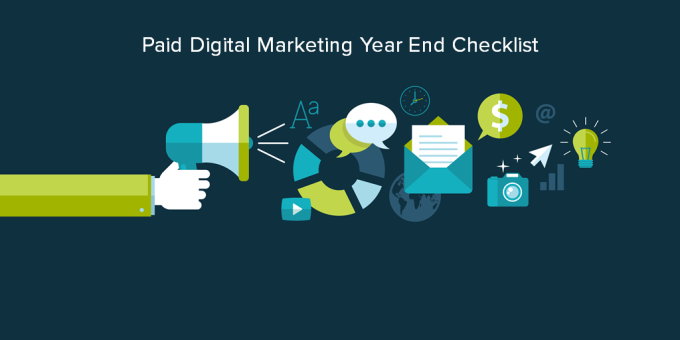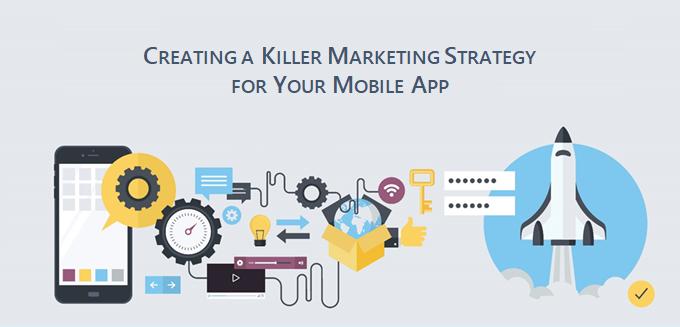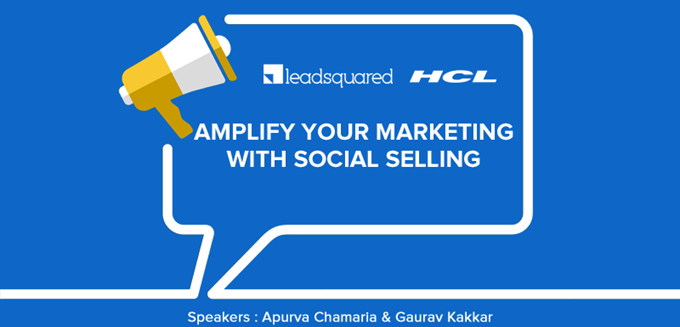Everything you need to know about social selling was discussed in the webinar on social selling with the authors of this brilliant book, “You are the Key – Unlocking doors through social selling.”
The book, You are the Key, written by HCL’s Apurva Chamaria and Gaurav Kakkar, talks about the future of businesses using social selling and also about B2B social media marketing for social selling. The book answers the why’s, how’s, do’s and don’ts of social selling and includes real-world examples that compel you to understand and acknowledge the importance of social selling.
If you are looking for more insights on social selling, this webinar would be a great place to start:
Here’s a write-up of the Q&A from the session:
1. What is the difference between social media marketing and social selling?
Social media marketing is generally done for a particular brand with the objective of
- Defining specific social media strategy for the brand and aligning all the activities to it
- Communicating the brand value – Communicating the diverse portfolio of products and services of the brand
- Keeping the audience updated about the latest information about the company.
Social selling is applied with a very focused objective, which is to reach out to a specific audience with a specific message, to make them aware of the product and services.
In social selling, you measure a lot of the bottom of the funnel metrics, like what are the number of contacts created, what is the increase in the size of opportunities, etc. You don’t have such in-depth metrics in social media marketing.
2. How do you build trust through social selling?
The right way to build trust is to be ready to help the other person on social media and make yourself dependable. Don’t start with a sales pitch and never try to sell in the first go. Try to understand the pain points. Try to understand why the person is looking for a particular solution. and how you can help him / her achieve their business objective.
3. Should we use paid marketing in social media?
Paid media can be leveraged if you feel that the relevant target audience is present on that social network. Within HCL, we use a lot of LinkedIn paid media to reach out to prospects. In fact, we did a multi-channel attribution last year where we found that there is a positive contribution of LinkedIn and other channels. So paid marketing definitely works and unless you try it, you will never know.
For attribution, use tools like Google Analytics Premium or any other software.
For more insights on paid marketing in social media, take a look at this webinar from last year on Paid Digital Marketing – The Year End Checklist

4. Do you think it is wise to ask the prospect for other connections? If yes, how soon do you think one can initiate this approach?
Not until and unless you have a relationship. I get several such requests. It should ideally be very very specific – which means, “I want to be introduced to somebody called Jayanth in Coca-Cola who is the marketing director. This is my proposition for him. I think it will be very useful for Jayanth. Would you kindly mind introducing me to him? If for some reason you find yourself unable to do so, it’s perfectly okay and thanks in advance.” [This is an example].
What should definitely not be done is doing large scale mass, non-customized, non-individualized prospecting towards others.
5. How do you deal with privacy while social selling?
Legally you can approach anyone through social media. If the person doesn’t want to be approached, they would generally have such settings in place. For instance, on Facebook you can opt to only receive friend requests from friends or mutual friends. Similarly, on Twitter, you can choose to make people send you requests before allowing them to follow you.
So you need not worry about privacy but the only thing you need to worry about is that you don’t bombard and don’t over engage with the prospect when they are not interested.
6. How do you align social selling with traditional selling methods?
Social selling is not a substitute for traditional selling methods. It’s complimentary. If you are going to approach an individual, it’s important to check the social presence of the individual. At least look at their LinkedIn profile. That is a very simple way to get to know the prospect. There are other ways mentioned in this book.
7. What should be the frequency of your social approach, like tweets and replies, as one normally loses interest after the first touch point?
At HCL, we ask our sales professionals to follow relevant handles on Twitter.
For instance, if you are in the IT industry, follow Gartner or Forrester and other handles that are relevant to the industry. In fact, there are handles for specific topics like IOT, Cloud Computing, which you can follow.
In the beginning, it is difficult to find content and is also difficult to start tweeting. But once you find that content, it’s easy to share your point of view, retweet it or share that with the relevant audience. This is one way of curating content.
One other way could be to use LinkedIn Pulse. If you have a point of view about something, publish it since that can reach out to your connections. The other thing is that you can cross market it on other platforms like Facebook, Twitter. You should also look at Quora. I have found that it’s a great content provider and you not only publish content but you can also curate a lot of content from Quora.
8. Should you carry on with social activities along after breaking the ice with the prospect over social media? Do you log social activities in your CRM?
Why not? You should carry on with your social activities but not like the way you started. In this case, the communication would be different (more casual) because you have already built a connection with the prospect.
The ideal way would be to log in the social media activities into the social CRM but from what I have seen, only a handful of organizations follow it. There are very few tools which allow that and it involves a huge amount of investment in terms of time (to log your activities to the CRM system.)
It is useful because if the sales person leaves (the organization for example), the next person can carry on the conversation. Most sellers also have the organization name on them. So although most of the relationship is formed with the person, there is a whole soft brand that is created for the organization. For example, when a Flipkart employee connects with you on Twitter, although the tweet is individual, he / she is still representing the brand. So you still need to be careful about your social activities even after breaking the ice.
9. How can you measure social success?
Go to Google and search for ‘Social Selling Index’. Log in with LinkedIn credentials. Anything above 80 is a very good score. I know of companies who are planning to use this social selling score in the performance review of sales individuals/professionals. It’s a global benchmark that you can use.
The other measurement platforms we use at HCL, apart from social selling score, are engagement rate, reach index and the cloud score for every individual. That’s how we are able to demonstrate the ROI of the program.
Ideally, you should measure social selling across the funnel. Start with, what is the number of impressions which are increasing, to CTRs, to actually getting down to engagement and shares. On Facebook it’s PTAT.
Here’s an interesting thing we tried at HCL: Once we launched the program, we enabled our CRM system to tag a particular opportunity if it comes through a social or digital channel, making is a very relevant way to prove the ROI of the program.
It’s very important because at the end of the project or while the project is going on, you start getting a lot of questions on what is the ROI, etc. So if your CRM is not integrated, and you are actually not measuring what is attributing directly to social selling, that’s a question which will always be tough to answer.
10. Is it possible to link social selling to specific ideas? Will its essence be lost then?
It is possible to link it to a specific idea. However, what one should be careful about is, like in real life, as soon as you meet a person, you won’t start selling to them. So you might want to share a thought or a proposition about your product or service but don’t start selling to them as soon as you interact with them on social media. Get time to know them. Appreciate their views. Exchange information and talk about topics of their interest and thereafter, it is a perfectly fair game to bring up something of your interest.
11. If people don’t see immediate ROI in the sales profession, they tend to abandon it. What is your take on this, which is particularly a problem among start-ups?
It’s not really a problem for just start-ups. This, in fact, is a big challenge for big organizations like HCL also. For any program, it’s very important to keep the sales team excited about it. One of the ways is chain management.
For instance, we created simple weekly contests when we a launched a particular program, like, ‘which salesperson is getting maximum connections in a week, which salesperson is posting maximum original content in a week,’ and so on? We came up with various cuts. And that helped as a motivating factor.
In the case of startups, everything is about quick ROI action. One way to tackle this is to keep measuring what you are doing to see if the efforts are generating results.
In our book, a series of growth hacks have been described. There are ways to do things very very efficiently and cost effectively. Check them out.
12. How do we recognize buying signals real time?
If your target audience is present on Twitter, you can try this. Put alerts in place so that every time a specific prospect posts a tweet, you will be notified.
Here’s an example: I’m the head of marketing at HCL. Somebody from an advertising agency or a digital marketing agency has put a notification on my Twitter handle. So every time I tweet, they will get an alert. It will not get submerged in the field.
Buying signals are of two kinds:
- Stated Signal – You can state a buying signal saying, “I’m looking for a vendor” or “I’m currently very unhappy with the level of service I’m getting from my current vendor.”
- Unstated Signal – There are unstated or subliminal mind signals, which tells you what the person is thinking about. For instance, if a lot of my tweets are about VR (Virtual Reality), it’s obvious that there is something going on in my mind which is causing me to either tweet about it or write about it.
So sellers should be conscious about both stated and unstated signals.
You could also try tools like Hootsuite, Needtagger and other cloud software to monitor your prospects, relevant topics and identify buying signals.
13. Can you give an example of a particular digital media campaign that performed really well?
HCL hires about 30000 people every year. Now, most of the job descriptions are very boring. They are usually lengthy pieces of text. If you remove the company name or logo, all of them read the same. So we did something different last year.
We decided to create video job descriptions which would be witty and interesting to watch. We created a campaign called Hirals, which was a combination of two words, ‘hiring’ and ‘viral videos’. That campaign did really well and we got about 20000-25000 job applications. And these videos were very inexpensive to make and completely shot on iPhone.
We not only use campaigns to create brand awareness but also demand generation and digital presence. And that’s something you should aim for as well.
14. Is social selling more effective for client prospecting over traditional methods?
Social selling is not going to replace traditional selling. You will still have to do direct selling, meet people, etc. You will still have to negotiate with them on the pricing. It is just a booster shot on traditional selling. If you do social selling well, it is going to pump up your traditional selling magnificently. You really don’t expect people to buy a 50 million dollar-100 million dollar deal on Twitter. (Breaking the ice, building trust and building a relationship can happen online / digitally but traditional/offline methods are still very important to actually close the deal.)
You really don’t expect people to buy a 50-100 million dollar deal on Twitter. Breaking the ice, building trust and building a relationship can happen online or digitally but traditional or offline methods are still very important to actually close the deal.
15. What precautions should be taken while using social media?
We have a list of what need not be done.
- Don’t bombard your prospects with tons of messages if they are not responding to you.
- Don’t start with a sales pitch.
- Don’t say negative things about your competitors on social media, especially if you have your company name on your Facebook or Twitter profile.
- Don’t talk about confidential information in public. [For instance, the project you have won, the size of the deal or who are the competitors, etc]
Never do anything on social media that you wouldn’t do in real life. Just because social media gives you a veneer of anonymity and you can sit in your living room, does not mean you can become disagreeable or rude. All of us should watch out for that.
16. Does social selling work for app marketing too?
Yes, social selling can be applied to any field of marketing including app marketing. Social selling enables a seller to identify the target audience, connect with them and engage, creating lasting relationships. App marketing is impacted by influencers and influencers can be targeted using social selling.
For more on app marketing, take a look at this webinar on Creating a Killer App Marketing Strategy to Get Tons of Users

17. For a new B2B manufacturing organization, how will social media have an impact on purchase department of customers (because purchase usually functions with their own database history)?
Social media impacts all the phases of buying and for all the industries. Before buying the product or service, a decision maker usually searches the information on the internet. Generally, a B2B manufacturing industry involves more than 3 decision makers during the deal and it is very important to leverage social selling as most buyers are looking for the information through online channels.
18. Is it advisable to invest in Facebook for social selling for B2B manufacturing company?
Yes, Facebook can be very useful for social selling as it:
- Provides the information about the liking and disliking of the decision makers.
- Provides personal details about the individuals which can be conversation starters.
- Can get you introduced to a new decision maker through common connections.
19. How is social selling relevant in the education space where students are the prospects?
Students have a lot of queries related to courses and programs which cannot be handled using traditional channels alone like website, phone, or email. An institute can introduce human touch and provide personalized responses to the students by adopting social selling. Moreover, social selling can be leveraged by existing students and faculty members of the institute.
For more inputs on education marketing, take a look at these resources on education marketing.

20. What is the difference between social engagement and social selling?
While social selling is always P2P, social engagement is a result of social selling. Any successful social seller has to first engage the target audience. But an important point to be considered here is that objective of social engagement can vary and can be different from social selling.
21. Do you see a profile ‘Social Development Rep’ coming up in marketing/sales team in the future?
It is already there. Many companies have social selling evangelist which can be either a contractual or a permanent role. The responsibility includes the success of the social selling program withing the organization.
22. Is there any one tool that can help us beat the competition, especially in social selling?
Hootsuite is one of the best social selling tools in this case. It can track not only the success of an individual’s social selling efforts but can also analyze how competitors are performing with respect to social selling.
Visit our blog for more tips on online marketing, past webinar recordings and other marketing blog posts.










